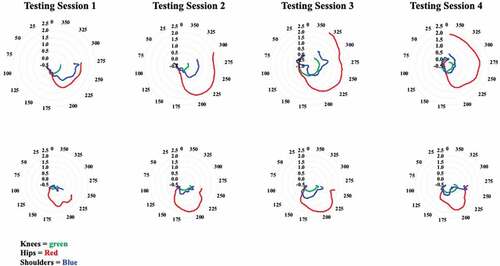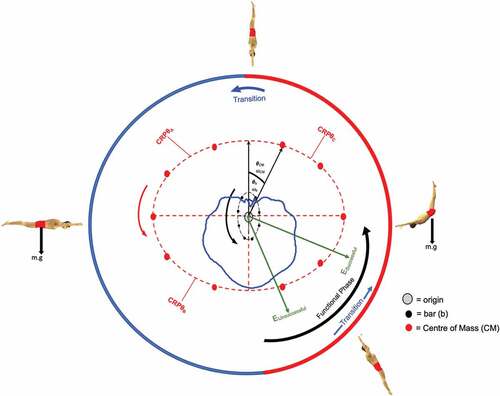Figures & data
Figure 1. Group average of critical biomechanical energetic variables about the bar during testing sessions 1, 2, 3, and 4. Energetic variables include maximum energy input (Emax, J), rate of energy input (Erate, Js−1), angular position (θEmax, °), and angular velocity (ωEmax, °s−1) when Emax occurs

Figure 2. Average percentage (%) contribution to total joint work from the knees (KW, green), hips (HW, red), and shoulders (SW, blue) during testing days 1–4, for groups: 1, 2, and 3

Figure 3. Joint work at the knees, hips and shoulders during testing sessions 1–4, for one participant from group 1 (top row) and one participant from the least successful group 3 (bottom row). Knees = green, Hips = Red, Shoulders = Blue

Table 1. Multiple stepwise regression with maximum swing height (θMaxcircle) as the criterion variable (each model relates to a specific testing day)
Table 2. Multiple stepwise regression coefficients, constant and Beta (B). θcircle as the criterion variable and each model relates to a specific testing day
Table 3. Linear regression matrix of the key energy variables associated with swing height
Figure 4. Diagrammatic representation of the successful novice, continuous, longswing with the gymnast rotating anti-clockwise about the bar. The two-phase model blue semi-circle (exploiting free fall) and red semi-circle (energy Input) are interspersed a two transition 1. during the handstand phase and 2 during the energy input phase. The functional phase is highlighted and representative of energy input (E) for unsuccessful and successful novice longswing is illustrated by green arrows. The candidate collective variable: Continuous relative phase of the bar – centre of mass interaction is shown by the red dashed line. CRPθA (initiation of first out of phase sequence); CRPθB (initiation of second out of phase sequence) and CRPθC (end of second out of phase sequence). CM dynamics (blue line: Radial angular velocity of CM) of a successful participant (P05) from the current study

